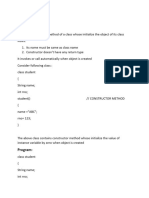0 ratings0% found this document useful (0 votes)
24 viewsClasses Objects
Classes Objects
Uploaded by
Santhosh KumarClasses and Objects in Java follow the principles of object-oriented programming. A class defines common properties of objects and acts as a template for creating objects. An object is an instance of a class that contains states (attributes) and behaviors (methods). Classes can contain fields, methods, constructors, and blocks. Objects represent real-world entities and contain unique identities, states, and behaviors. A class is instantiated to create objects that share the class's attributes and behaviors but have unique state values.
Copyright:
© All Rights Reserved
Available Formats
Download as PPTX, PDF, TXT or read online from Scribd
Classes Objects
Classes Objects
Uploaded by
Santhosh Kumar0 ratings0% found this document useful (0 votes)
24 views25 pagesClasses and Objects in Java follow the principles of object-oriented programming. A class defines common properties of objects and acts as a template for creating objects. An object is an instance of a class that contains states (attributes) and behaviors (methods). Classes can contain fields, methods, constructors, and blocks. Objects represent real-world entities and contain unique identities, states, and behaviors. A class is instantiated to create objects that share the class's attributes and behaviors but have unique state values.
Original Title
Classes-objects
Copyright
© © All Rights Reserved
Available Formats
PPTX, PDF, TXT or read online from Scribd
Share this document
Did you find this document useful?
Is this content inappropriate?
Classes and Objects in Java follow the principles of object-oriented programming. A class defines common properties of objects and acts as a template for creating objects. An object is an instance of a class that contains states (attributes) and behaviors (methods). Classes can contain fields, methods, constructors, and blocks. Objects represent real-world entities and contain unique identities, states, and behaviors. A class is instantiated to create objects that share the class's attributes and behaviors but have unique state values.
Copyright:
© All Rights Reserved
Available Formats
Download as PPTX, PDF, TXT or read online from Scribd
Download as pptx, pdf, or txt
0 ratings0% found this document useful (0 votes)
24 views25 pagesClasses Objects
Classes Objects
Uploaded by
Santhosh KumarClasses and Objects in Java follow the principles of object-oriented programming. A class defines common properties of objects and acts as a template for creating objects. An object is an instance of a class that contains states (attributes) and behaviors (methods). Classes can contain fields, methods, constructors, and blocks. Objects represent real-world entities and contain unique identities, states, and behaviors. A class is instantiated to create objects that share the class's attributes and behaviors but have unique state values.
Copyright:
© All Rights Reserved
Available Formats
Download as PPTX, PDF, TXT or read online from Scribd
Download as pptx, pdf, or txt
You are on page 1of 25
Classes and Objects
Classes and Objects
⚫ Java is an Object-Oriented programming
language
⚫ Object − Objects have states and behaviors. Example:
A dog has states - color, name, breed as well as behaviors –
wagging the tail, barking, eating. An object is an
instance of a class.
⚫ Class − A class can be defined as a template/blueprint
that describes the behavior/state that the object of its
type support.
Classes
⚫ A class is a group of objects which have common
properties. It is a template or blueprint from which
objects are created. It is a logical entity. It can't be
physical. A class in Java can contain:
⚫ fields
⚫ methods
⚫ constructors
⚫ Blocks
class
< class_name> {
field;
method;
}
Objects
⚫ It is a basic unit of Object Oriented Programming
and represents the real life entities. A typical Java
program creates many objects, which as you know,
interact by invoking methods. An object consist
of :
⚫ State : It is represented by attributes of an object. It
also reflect
the properties of an object.
⚫ Behavior : It is represented by methods of an object. It
also reflects the response of an object with other objects.
⚫ Identity : It gives a unique name to an object and enables
one object to interact with other objects.
Objects
Objects
⚫ Objects correspond to things found in the real world.
⚫ For example, a graphics program may have objects
such as “circle”, “square”, “menu”.
⚫ An online shopping system might have objects such
as “shopping cart”, “customer”, and “product”
⚫ When an object of a class is created, the class is said
to be instantiated.
⚫ All the instances share the attributes and the behavior
of the class. But the values of those attributes, i.e. the
state are unique for each object.
⚫ A single class may have any number of instances.
Objects
Object and Class Example: main outside
class
class Student
{ int id; String name;
}
class TestStudent1{
public static void main(String args[]){
Student s1=new Student();
System.out.println(s1.id);
System.out.println(s1.name);
}
}
Main inside the class:
public static void main(String args[]) {
//declaring the objects of the class City
//creating a class named City City metro1,metro2;
public class City
{ //Instantiating the objects of the class using the
//declaring class variables new keyword
public String name; metro1 = new City();
public long population; metro2 = new City();
//defining the method of the class metro1.name ="Delhi";
public void display() metro1.population = 10000000;
{ System.out.println("Details of metro city 1:");
System.out.println("City name: " metro1.display(); //display() method is being
+name); invoked for the object metro1
System.out.println("Population: "
+population); metro2.name ="Bangalore";
} metro2.population = 5000000;
System.out.println("Details of metro city 2:");
metro2.display(); //display() method is being
invoked for the object metro2
Object and Class Example: Rectangle
class Rectangle{
class TestRectangle1{
int length;
public static void main(String
int width;
args[]){ Rectangle r1=new
void insert(int l, int w){
Rectangle(); Rectangle r2=new
length=l;
Rectangle(); r1.insert(11,5);
width=w;
r2.insert(3,15);
}
r1.calculateArea(
void calculateArea()
);
{
r2.calculateArea(
System.out.println(length*width);
);
}
}
}
}
Anonymous object [If you have to use an object
only once, an anonymous object is a good
approach.]
class Calculation{
void fact(int n)
{ int fact=1;
for(int i=1;i<=n;i++)
{ fact=fact*i;
}
System.out.println("fact
orial is "+fact);
}
public static void
main(String args[]){
new
Calculation().fact(5);//cal
ling method with
anonymous object
Array of objects
Public Class Account
{
Char Name[20];
int Account Type; AC[0].Name ox10 Arunkumar
int Account AC[0].Account Type ox20 1
Number; float
AC[0].AccountNumber ox22 1234567
Balance
AC[0].Balance ox24 10000.00
Input( ); AC[1].Name ox40 arun
Deposit (int x ); AC[1].Account Type ox60 2
Withdraw (int AC[1].AccountNumber ox62 1234568
x ); Enquire ( ); AC[1].Balance ox64 10000.00
};
Account AC[0]; AC[2].Name ox70 kumar
Account AC[1]; AC[2].Account Type ox90 3
AC[2].AccountNumber ox92 1234569
Account AC[2]; AC[2].Balance ox94 10000.00
Public Class
Account public void enquire()
{ int Account {
String
int Name;
Account Type;float Balance;
Number;
System.out.println(balance);
public Account(String name, int act, }
int acn, float bal)
Public static void main(String args[ ])
{
{
this.name=name
Account AC[] =new Account[3]
this.account type=act;
AC[0] = new Account (“abc”,1, 1234,
this.account
100.00) AC[1] =new Account(“def”,2, 123,
number=acn;
100.00)
this.balance=bal;
AC[2] =new Account(“ghi”,2, 12,
}
100.00) For(int i=0;i<3;i++)
Public void deposit( int x)
AC[i].Deposit(500);
{
balance +=x;
For(int i=0;i<3;i++)
}
AC[i]. Withdraw (500);
Public void withdraw(int
x) }
{ }
balance-=x;
Access Specifiers
Java Access Specifiers (also known as Visibility Specifiers ) regulate access to classes,
fields and methods in Java.
These Specifiers determine whether a field or method in a class, can be used or invoked
by another method in another class or sub-class.
Access Specifiers can be used to restrict access. Access Specifiers are an integral part of
object-oriented programming.
⚫ Public - visible to any class in the Java program
⚫ Private - cannot be accessed by anywhere outside the enclosing class.
⚫ Protected -
⚫ Default - accessible only by classes in the same package
Public specifiers
⚫ Public Specifiers achieves the highest level of accessibility.
⚫ Classes, methods, and fields declared as public can be
accessed from any class in the Java program, whether
these classes are in the same package or in another
package.
Privat
ePrivate Specifiers achieves the lowest level of accessibility.
⚫
⚫ Private methods and fields can only be accessed within
the same class to which the methods and fields belong.
⚫ Private methods and fields are not visible within
subclasses and are not inherited by subclasses. So, the
private access specifier is opposite to the public access
specifier.
⚫ Using Private Specifier we can achieve encapsulation and
hide data from the outside world.
Protected
⚫ The protected access modifier is specified using the
keyword
protected.
⚫ The methods or data members declared as protected
are accessible within same package or sub
classes in different package.
Defaul
t When no access modifier is specified for a class , method
⚫
or data member – It is said to be having the default
access modifier by default.
⚫ The data members, class or methods which are not declared
using any access modifiers i.e. having default access
modifier are accessible only within the same
package.
Access Specifiers table
Static members and methods
Static members belong to the class instead of a specific
instance, this means if you make a member static, you
can access it without object.
Static methods in Java
⚫ Static method in Java is a method which belongs to the class
and
not to the object. A static method can access only static
data.
⚫ It is a method which belongs to the class and not to
the object(instance)
⚫ A static method can access only static data. It can
not access non-
static data (instance variables)
⚫ A static method can call only other static methods
and can not call
a non-static method from it.
⚫ A static method can be accessed directly by the class
name and
doesn’t need any object
//Java Program to demonstrate the use of static variable
class Student{
int rollno;//instance variable
String name;
static String college ="ITS";//static variable
//constructor
Student(int r,String n){
rollno = r;
name = n;
}
//method to display the values
void display (){System.out.println(rollno+" "+name+" "+college);}
}
//Test class to show the values of static variable
public class TestStaticVariable1{
public static void main(String args[]){
Student s1 = new Student(111,"Karan");
Student s2 = new Student(222,"Aryan");
s1.display();
s2.display();
}
}
Example of a class
Public Class Account
{
Char Name[20];
int Account Type; AC1.Name ox10 Arunkumar
int Account AC1.Account Type ox20 1
Number; float
AC1.AccountNumber ox22 1234567
Balance
AC1.Balance ox24 10000.00
Input( ); AC2.Name ox40 arun
Deposit (int x ); AC2.Account Type ox60 2
Withdraw (int AC2.AccountNumber ox62 1234568
x ); Enquire ( ); AC2.Balance ox64 10000.00
};
Account AC1; AC3.Name ox70 kumar
Account AC2; AC3.Account Type ox90 3
AC3.AccountNumber ox92 1234569
Account AC3; AC3.Balance ox94 10000.00
Public Class
Account public void enquire()
{ int Account {
String
int Name;
Account Type;float Balance;
Number;
System.out.println(balance);
public Account(String name, int act, }
int acn, float bal)
Public static void main(String args[ ])
{
{
this.name=name
Account AC1=new Account(“arun”,1, 1234, 100.00)
this.account type=act;
Account AC2=new Account(“ar”,2, 123, 100.00)
this.account
Account AC3=new Account(“arn”,2, 12,
number=acn;
100.00) AC1.Deposit(500);
this.balance=bal;
AC2.Deposit(500);
}
AC3.Deposit(500);
Public void deposit( int x)
AC1.Withdraw(500);
{
AC2.
balance +=x;
Withdraw(400);
}
AC3.
Public void withdraw(int
x) Withdraw(400);
{ }
balance-=x; }
You might also like
- Repair XT250 Yamaha 1980 - 1983Document49 pagesRepair XT250 Yamaha 1980 - 1983David Bough93% (28)
- Creating Banks - Branches in Oracle Apps R12Document11 pagesCreating Banks - Branches in Oracle Apps R12raj_reddy1432004No ratings yet
- Class XiiDocument24 pagesClass XiiPriyansha VermaNo ratings yet
- Assignments Pooja GaikwadDocument23 pagesAssignments Pooja Gaikwad521 - Pooja GaikwadNo ratings yet
- Object Classes Methods and ConstructorsDocument55 pagesObject Classes Methods and ConstructorsMeena KumarNo ratings yet
- JPR Chap 02 New CopyDocument227 pagesJPR Chap 02 New Copydonnoorain69No ratings yet
- 05 Java Fundamental Method Overloading, StaticDocument19 pages05 Java Fundamental Method Overloading, Staticamitchaurasia774No ratings yet
- ConstructorDocument15 pagesConstructorsamadhanbodkhe222No ratings yet
- Unit-5 OOSD with C++ Notes_compressed_49156168_2024_12_27_00_38Document46 pagesUnit-5 OOSD with C++ Notes_compressed_49156168_2024_12_27_00_38ieelnerranoNo ratings yet
- 04-Class and Object Manipulation (Revised)Document49 pages04-Class and Object Manipulation (Revised)Arif IstiaqNo ratings yet
- Lecture 03 05Document46 pagesLecture 03 05wajeehaadeel57No ratings yet
- OOC Module 3Document43 pagesOOC Module 3Vinayak TelsangNo ratings yet
- Classes and Objects: Unit 2Document52 pagesClasses and Objects: Unit 2shivanshNo ratings yet
- Constructors With Default Arguments-1Document43 pagesConstructors With Default Arguments-1navikaundal49No ratings yet
- Static Data Members & Object As ArgumentDocument6 pagesStatic Data Members & Object As Argumentmail.sushilk8403No ratings yet
- Java Unit 2Document37 pagesJava Unit 2shamithashibuNo ratings yet
- Java Study MaterialDocument9 pagesJava Study MaterialTRANAND TRNo ratings yet
- What Is A ClassDocument9 pagesWhat Is A ClassEthio JoyNo ratings yet
- Create A Class: Unit Ii Classes, Objects and MethodsDocument35 pagesCreate A Class: Unit Ii Classes, Objects and MethodsneethujayaramNo ratings yet
- Unit 3 - OOPs ConceptsDocument40 pagesUnit 3 - OOPs Conceptsbarla geethaNo ratings yet
- 6 Const Inheri Interf Abst (Unit 1)Document35 pages6 Const Inheri Interf Abst (Unit 1)Abhinav KaushikNo ratings yet
- Java Programming LAB RECORD PDFDocument21 pagesJava Programming LAB RECORD PDFJayakrishna BhasiNo ratings yet
- Class & ObjectDocument121 pagesClass & Objectpiyushsingh8604No ratings yet
- Java Exam NotesDocument18 pagesJava Exam Notesphilipshen1969No ratings yet
- Lab Task 4 OopDocument31 pagesLab Task 4 OopZuwanish MohammadNo ratings yet
- Unit-2 StringDocument15 pagesUnit-2 StringrvmehtaictspceNo ratings yet
- Assigning Object Reference VariablesDocument10 pagesAssigning Object Reference VariablesmadirikiranNo ratings yet
- Week 2Document8 pagesWeek 2billionoidNo ratings yet
- Unit 5 Classes and Objects: Defining The Class in C++Document7 pagesUnit 5 Classes and Objects: Defining The Class in C++Siwani sainiNo ratings yet
- (Lec-15) Java SE (Explicit, Initializers, Constructors)Document12 pages(Lec-15) Java SE (Explicit, Initializers, Constructors)malise2997No ratings yet
- Object Oriented Programming Class 2Document28 pagesObject Oriented Programming Class 2Saqlain AhmadNo ratings yet
- Class:10 Subject: Computer Applications: LS 10. Constructors Important PointsDocument7 pagesClass:10 Subject: Computer Applications: LS 10. Constructors Important Pointskoushik reddyNo ratings yet
- CH_2 Classes and ObjectsDocument23 pagesCH_2 Classes and Objectsabhishekmane280No ratings yet
- Classes and ObjectsDocument39 pagesClasses and Objectsshivani.gargNo ratings yet
- Modified Objects and Classes PLDocument18 pagesModified Objects and Classes PLSuraj TamangNo ratings yet
- Object-Oriented Design & Patterns Chapter Topics: The Java Object ModelDocument23 pagesObject-Oriented Design & Patterns Chapter Topics: The Java Object ModelJoel Juares MoscosoNo ratings yet
- Classes and ObjectsDocument89 pagesClasses and ObjectsShambhavi ParasharNo ratings yet
- Class - Constructor ThisDocument14 pagesClass - Constructor Thisguru cseNo ratings yet
- Classes and ObjectsDocument91 pagesClasses and Objectsdevinachauhan2002No ratings yet
- AppdevDocument45 pagesAppdevbookwormMDNo ratings yet
- Object Oriented Programming Through C C2Document18 pagesObject Oriented Programming Through C C2Shailesh WagholeNo ratings yet
- Ch08 Objects and ClassesDocument116 pagesCh08 Objects and ClassesjoeNo ratings yet
- Anonymous ArrayDocument6 pagesAnonymous ArraysathiyavijayanNo ratings yet
- Chem NotesDocument12 pagesChem NotesAbhinav GuptaNo ratings yet
- Java Programming Unit-I III B.Tech. I SEM (R15) : Classes and ObjectsDocument18 pagesJava Programming Unit-I III B.Tech. I SEM (R15) : Classes and ObjectsNishanNo ratings yet
- CN Oops 1 PDFDocument11 pagesCN Oops 1 PDFLakshay SoodNo ratings yet
- Unit 2 (Objects and Classes)Document70 pagesUnit 2 (Objects and Classes)Ridhi AggarwalNo ratings yet
- 2.arrays, Classes and ObjectsDocument85 pages2.arrays, Classes and ObjectsSaumya PancholiNo ratings yet
- 6.CLASSDocument4 pages6.CLASSviswadevadiNo ratings yet
- Basics, OOP, and InterfacesDocument49 pagesBasics, OOP, and Interfacesgunarathneisuri11No ratings yet
- Class&constructorDocument9 pagesClass&constructorragulr239No ratings yet
- Unit-Ii NotesDocument35 pagesUnit-Ii Notesyaminisreeja03No ratings yet
- Chapter 2 JavaDocument14 pagesChapter 2 JavaNishath AshrafNo ratings yet
- Lecture 4-7-1Document73 pagesLecture 4-7-1Mayank AgarwalNo ratings yet
- Classes and Objects: ClassDocument5 pagesClasses and Objects: ClassSailesh RijalNo ratings yet
- (Noc) - Java Lab ProgramsDocument35 pages(Noc) - Java Lab Programsga568798No ratings yet
- Java Programming - Module 2Document83 pagesJava Programming - Module 2Ganesh MoreNo ratings yet
- polymorphismDocument11 pagespolymorphismRamsha ImranNo ratings yet
- Notes OOPS-1Document13 pagesNotes OOPS-1devanik2005No ratings yet
- Advanced C Concepts and Programming: First EditionFrom EverandAdvanced C Concepts and Programming: First EditionRating: 3 out of 5 stars3/5 (1)
- Java Inner ClassesDocument19 pagesJava Inner ClassesSanthosh KumarNo ratings yet
- Java PolymorphismDocument14 pagesJava PolymorphismSanthosh KumarNo ratings yet
- Module 6 VirtualizationDocument29 pagesModule 6 VirtualizationSanthosh KumarNo ratings yet
- CSE2005-Operating Systems: Scope Fall-Semester2021-2022Document13 pagesCSE2005-Operating Systems: Scope Fall-Semester2021-2022Santhosh KumarNo ratings yet
- VHDL Implementation of 128 Bit Pipelined Blowfish AlgorithmDocument5 pagesVHDL Implementation of 128 Bit Pipelined Blowfish AlgorithmAnonymous lPvvgiQjRNo ratings yet
- Leica Disto s910 User Manual 805080 808183 806677 en PDFDocument55 pagesLeica Disto s910 User Manual 805080 808183 806677 en PDFVina AnggrainiNo ratings yet
- Assignment 1 OSDocument36 pagesAssignment 1 OShs3905951No ratings yet
- Structure-First YearDocument12 pagesStructure-First Yearioemk251No ratings yet
- New Additive Packages For Self-Flowing High-Alumina and MgO Based Refractory CastablesDocument6 pagesNew Additive Packages For Self-Flowing High-Alumina and MgO Based Refractory CastablespetemberNo ratings yet
- Annex 3 Single Line DiagramDocument1 pageAnnex 3 Single Line DiagramafasNo ratings yet
- How Do You Address The Memory Areas in The SIMATIC S7-1200 - S7-1500 and in The Modb..Document2 pagesHow Do You Address The Memory Areas in The SIMATIC S7-1200 - S7-1500 and in The Modb..JuanAntonioButronLlamocaNo ratings yet
- Adorno Husserl Critical TheoryDocument19 pagesAdorno Husserl Critical TheoryMiguel ReyesNo ratings yet
- FIRST - SEMINAR - Project - 422 - 18.02.21 Final VersionDocument29 pagesFIRST - SEMINAR - Project - 422 - 18.02.21 Final VersionazizNo ratings yet
- Compiler Design Final NotesDocument22 pagesCompiler Design Final NotesVictor SarmacharjeeNo ratings yet
- Lab 8 - PWMDocument4 pagesLab 8 - PWMlol100% (1)
- Types of PropulsionDocument64 pagesTypes of PropulsionAnitha Raja BNo ratings yet
- Newton's Law of Cooling: e e - KTDocument2 pagesNewton's Law of Cooling: e e - KTAura Paige Montecastro-RevillaNo ratings yet
- Aiwa Dbx-ds30 Ver.1.0 Mini Hifi SystemDocument68 pagesAiwa Dbx-ds30 Ver.1.0 Mini Hifi SystemRodolfo CarruyoNo ratings yet
- Fluid Mechanics 2 Lab ManualDocument50 pagesFluid Mechanics 2 Lab ManualMuhammad IsmailNo ratings yet
- Pile Design ExampleDocument70 pagesPile Design ExampleRestie TeanoNo ratings yet
- CI Online Digipass Guide PDFDocument1 pageCI Online Digipass Guide PDFOryza GunawanNo ratings yet
- Oxidation and Wet Corrosion QuestionsDocument4 pagesOxidation and Wet Corrosion QuestionsMeng KiatNo ratings yet
- 5 Math - Lazy TDocument3 pages5 Math - Lazy Tapi-339307994No ratings yet
- US Army Medical Course MD0363100 Electrosurgical Apparatus PDFDocument36 pagesUS Army Medical Course MD0363100 Electrosurgical Apparatus PDFpeterwolf67No ratings yet
- Sample Sai Prudent QPDocument6 pagesSample Sai Prudent QPK YugandharNo ratings yet
- Product Datasheet Product Datasheet HB P 147W 865 110DEG IP65Document5 pagesProduct Datasheet Product Datasheet HB P 147W 865 110DEG IP65Dani Good VibeNo ratings yet
- Sma Grid Guard 10.0: Technical InformationDocument38 pagesSma Grid Guard 10.0: Technical InformationGary FortuinNo ratings yet
- Determination of Geomechanical Properties and Collapse Potential of A Caliche by in Situ and Laboratory TestsDocument12 pagesDetermination of Geomechanical Properties and Collapse Potential of A Caliche by in Situ and Laboratory TestsBárbara RodríguezNo ratings yet
- DensiometerDocument2 pagesDensiometergw2005No ratings yet
- Pragmatics: Grice'S Conversational Maxims Violations in The Responses of Some Western PoliticiansDocument23 pagesPragmatics: Grice'S Conversational Maxims Violations in The Responses of Some Western PoliticiansMohammad WorldNo ratings yet
- JD770 Calibration of Transmission ControllerDocument3 pagesJD770 Calibration of Transmission Controllerenriquevazquez27No ratings yet
- SWE3Document12 pagesSWE3Suraj DasguptaNo ratings yet





























































































